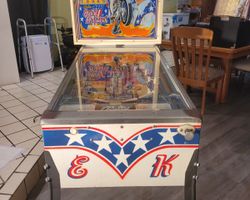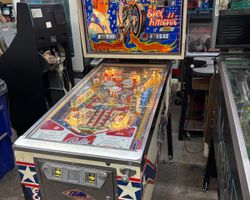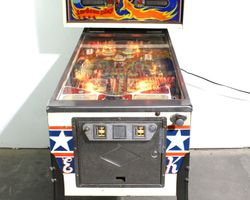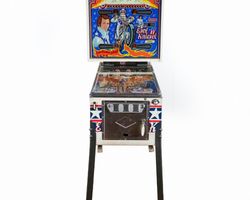Evel Knievel
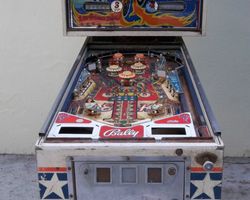
Average Prices: USD $300 to $2,900
Produced: January, 1977
Production Run: 155 units
Machine Type: Electro-mechanical
Players: 4
Design by: Gary Gayton
Art by: Paul Faris
In January 1977, Bally Manufacturing Corporation unveiled an electro-mechanical (EM) pinball machine that captured the audacious spirit of a daring showman: "Evel Knievel." This machine arrived at a time when licensed themes were beginning to gain traction in the pinball industry, and the persona of Evel Knievel, a figure synonymous with spectacular stunts and dramatic leaps, provided an ideal foundation for a vibrant and high-energy game. With a production run of approximately 155 units, this four-player EM machine, model number 1094, became a distinctive offering from Bally.
The design of "Evel Knievel" was a collaborative effort, with Gary Gayton orchestrating the playfield layout, ensuring a compelling and engaging experience. Complementing his mechanical design was the artwork of Paul Faris, whose distinctive style brought the Evel Knievel theme to life across the backglass and playfield. Faris’s illustrations captured the essence of the era and the dynamic energy of the theme, contributing significantly to the machine's visual identity. The machine's release coincided with a period of peak cultural visibility for its namesake, providing an immediate connection with players who followed his high-flying exploits. The deliberate choice of an EM platform for this initial iteration allowed it to leverage the robust and tactile feel characteristic of machines from that era.
Engineered for Excitement: Signature Features and Design
"Evel Knievel" stands out not only for its theme but also for its effective integration of mechanical features designed to enhance player engagement. The machine, typical of EM designs, foregoes complex digital displays for a clear, intuitive scoring system and electromechanical chimes that provide immediate audio feedback. The visual design, rendered by Paul Faris, features bold colors and dynamic depictions of stunts and imagery associated with Evel Knievel. This artwork is not merely decorative; it complements the game's high-speed nature, drawing the player into the daredevil theme.
Central to the design are two flippers, positioned for precise shot control. The playfield is populated with three pop bumpers, creating erratic ball movements and adding an element of unpredictability to gameplay. Two passive bumpers and two slingshots further contribute to the ball's chaotic trajectory, demanding quick reflexes from the player. These electromechanical components work in concert to deliver a kinetic experience, where the physics of the ball's movement dictate the flow, amplifying the game's intensity. The marriage of vibrant art and responsive mechanics ensures that each game is a flurry of lights, sounds, and exhilarating ball action.
The Stuntman’s Arena: Playfield and Mechanics
The "Evel Knievel" playfield is a carefully constructed arena designed to challenge players with a variety of shots and objectives. Dominating the lower half are the two flippers, providing the primary means of ball control and shot execution. Above them, two slingshots propel the ball back into the playfield with force, keeping the action dynamic. The mid-playfield features a prominent 5-bank drop target setup, offering a significant points opportunity upon completion. These targets reset once cleared, inviting repeated attempts and adding a layer of strategic depth.
Further up the playfield, six standup targets are strategically placed, requiring accurate shots to activate. Two spinning targets introduce an element of variable scoring, their values increasing with sustained hits. A kick-out hole provides a suspenseful moment, typically delivering the ball back into play after collecting a score or activating a feature. One notable design element is the "1000-point light," positioned in a way that requires players to navigate the ball through a tight passage between the flippers to score, adding a calculated risk/reward element to the lower playfield. The overall layout encourages a fast-paced game, where ball control and precise aiming are paramount, yet the various bumpers and targets ensure that unpredictable ricochets keep players on their toes. The artwork on the playfield, rich with imagery of motorcycles and stunt ramps, enhances the immersive quality, making the player feel part of the high-stakes world of Evel Knievel. The lighting, typical of EM machines, utilizes incandescent bulbs to highlight targets and scoring areas, creating a captivating glow that draws the player's eye to the action.
High-Flying Action: Gameplay Dynamics
The gameplay of "Evel Knievel" is defined by its energetic pace and a rewarding scoring system that encourages both skillful aiming and calculated risk-taking. The primary objective involves accumulating points by hitting various targets, but the game introduces unique challenges that elevate the experience beyond mere score chasing. Players are tasked with activating specific features and sequences to earn extra balls and "Specials," which are highly coveted rewards in EM pinball. The 5-bank drop targets, for instance, are critical for progression, offering substantial points and often contributing to feature activation.
A key element of the gameplay is the "CYCLE" feature, typically found on the right side of the playfield. Engaging this feature often requires a combination of precise shots and strategic target elimination. The two spinning targets, when repeatedly struck, can rapidly increase a player's score, making them high-priority targets. The design philosophy behind the layout subtly promotes a risk/reward dynamic; for example, the aforementioned "1000-point light" demands navigating the ball through a tight space near the flippers, a maneuver that, if successful, yields significant points but carries the inherent risk of an outlane drain. This strategic element adds depth to each shot, transforming casual play into a series of calculated decisions. The end-of-ball bonus system rewards players for hitting specific targets throughout their ball, adding a final flurry of points before the next ball is served, keeping the excitement going until the very end.
A Daredevil's Enduring Appeal: Reception and Legacy
"Evel Knievel" garnered significant positive feedback from the pinball community, solidifying its place as a well-regarded EM machine. Players frequently cite its fast, engaging, and interesting gameplay as a primary strength. The game's complex ruleset, which presents multiple challenges to earn specials and extra balls, is often highlighted as a contributor to its replayability. The risk/reward elements inherent in the playfield design are also frequently praised, encouraging strategic play beyond simply hitting targets.
The artwork by Paul Faris is largely considered a standout feature, with its distinct 1970s aesthetic and vibrant depictions resonating with many enthusiasts. The nostalgic value associated with the Evel Knievel theme itself often enhances the player experience, evoking fond memories for those who grew up during the daredevil's prime. The crisp, mechanical audio chimes, characteristic of Bally EM machines, are also frequently mentioned as a positive aspect, contributing to the overall classic pinball feel. While overwhelmingly positive, some minor critiques emerged; one reviewer found the artwork "too in your face," indicating that its bold style might not appeal to every sensibility. Another practical concern noted was the potential for rapid wear on the bumpers, a common issue with heavily played EM machines. Despite these minor points, the general consensus reinforces the machine's solid build and enjoyable gameplay.
"Evel Knievel" holds a distinct reputation in the pinball community, often considered a collectible EM machine. Its influence lies not in revolutionary mechanics but in its masterful execution of established EM principles, delivering a pure and exhilarating pinball experience. The fact that some players specifically prefer this EM version over its solid-state counterpart, also released by Bally in 1977, speaks to the enduring appeal of its mechanical action and unique playfield flow. It stands as a testament to Bally's design prowess during the late EM era, showcasing how a well-integrated theme, balanced playfield, and engaging objectives can create a memorable and highly sought-after pinball machine.
Sponsored Links
 Ebay Listings
Ebay Listings
 Auction Results
Auction Results
| Cost | Location | Date |
|---|---|---|
| USD $1,960 |  Florida, United States Florida, United States |
12 November, 2025 |
| USD $2,950 |  Pennsylvania, United States Pennsylvania, United States |
15 August, 2025 |
| USD $6,895 |  Arizona, United States Arizona, United States |
02 May, 2025 |
| USD $9,999 |  Utah, United States Utah, United States |
06 February, 2025 |
| USD $4,725 |  Montana, United States Montana, United States |
15 January, 2025 |
| USD $2,950 |  Florida, United States Florida, United States |
26 November, 2024 |
| USD $3,100 |  Pennsylvania, United States Pennsylvania, United States |
26 October, 2024 |
| CAD $3,000 |  Canada Canada |
09 September, 2024 |
| USD $1,800 |  Maryland, United States Maryland, United States |
15 August, 2024 |
| EUR €1,800 |  Nordrhein-Westfalen, Germany Nordrhein-Westfalen, Germany |
19 July, 2024 |


Private Policy · Search Website · Contact Us
As an eBay Partner, we may earn a commission from qualifying purchases made through links on this site, at no additional cost to you.
All trademarks and copyrighted materials remain property of their respective owners. All other content copyright 2007 - 2025 Pinpedia.

